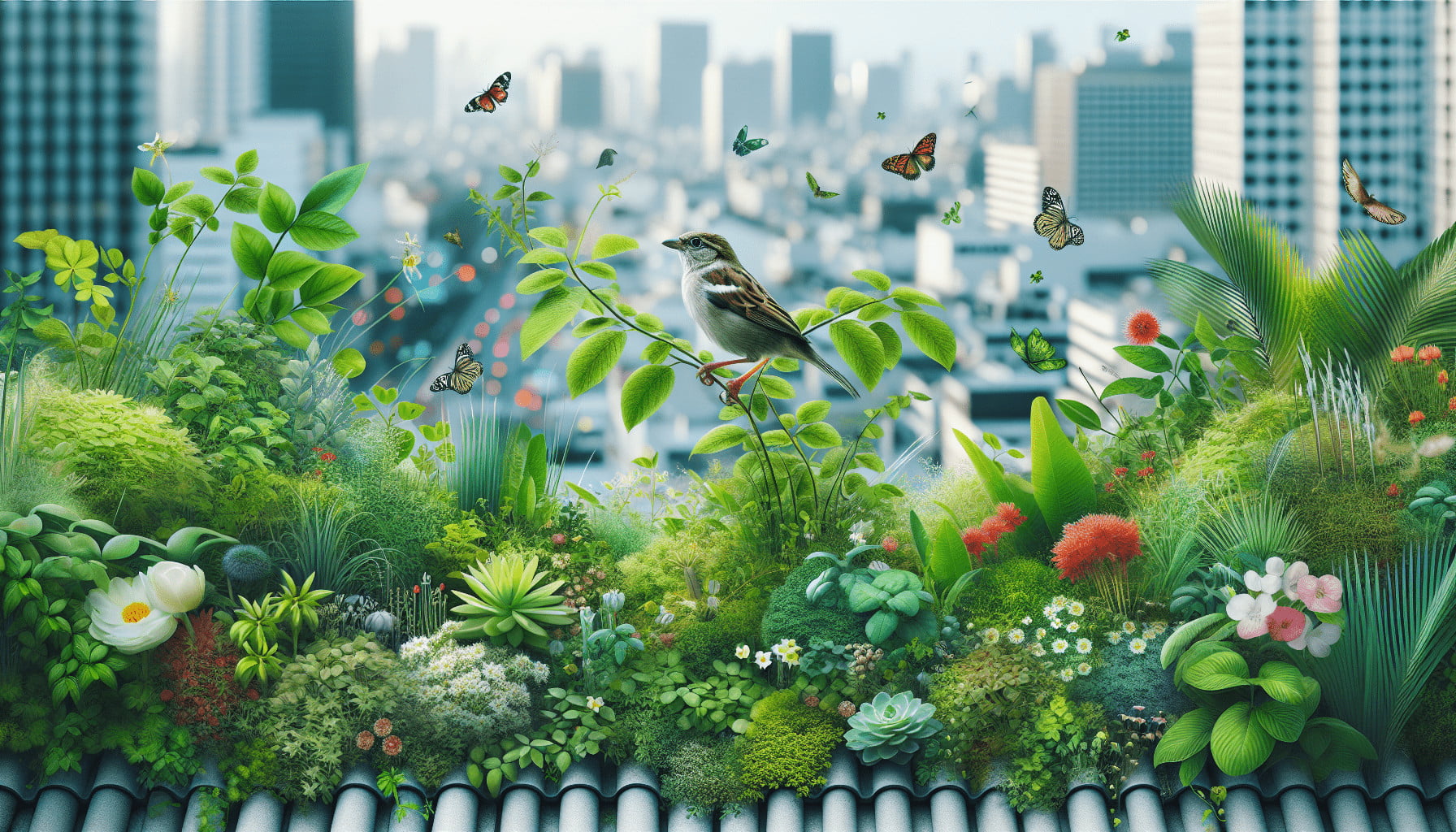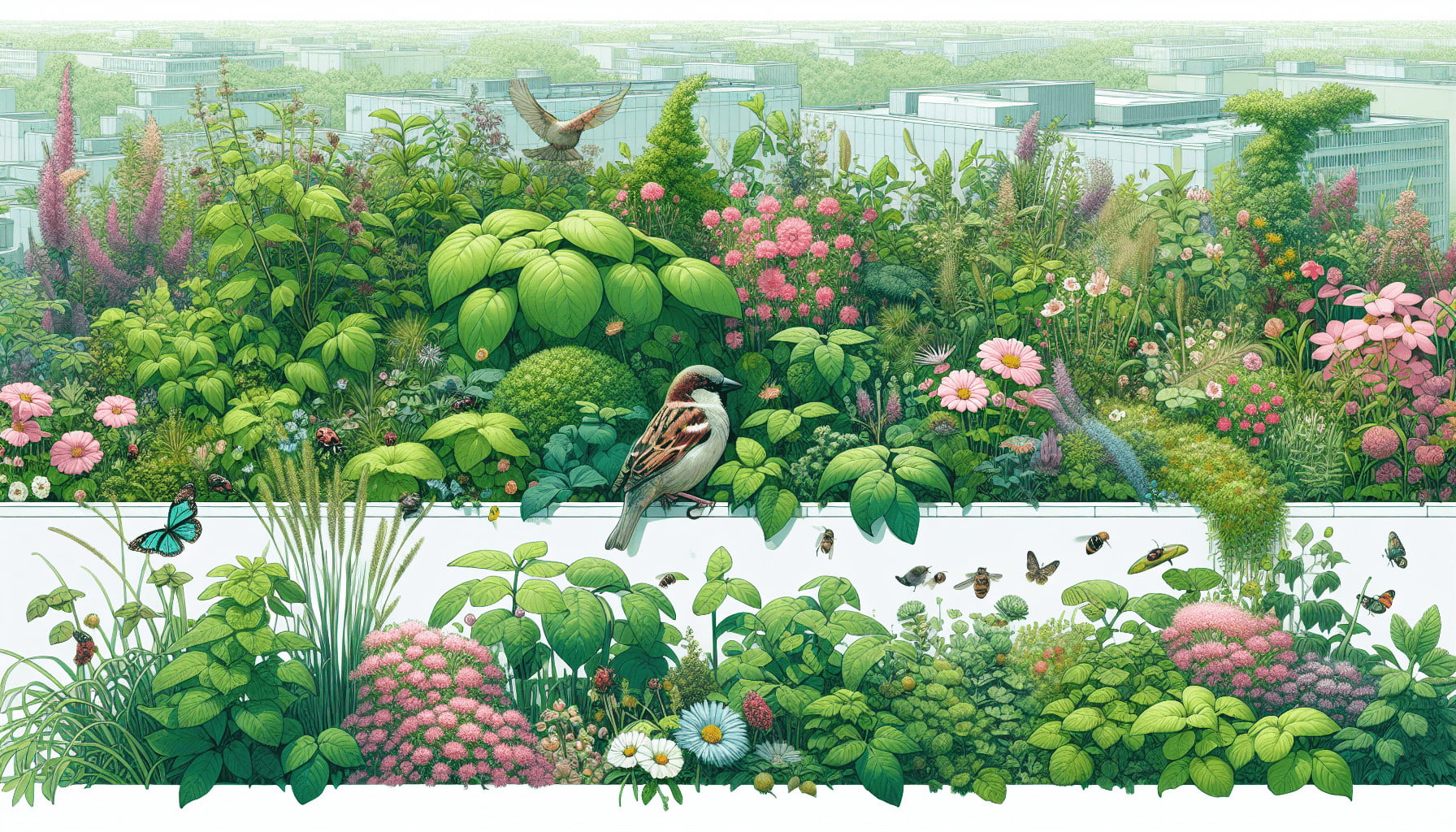By integrating green roof systems, urban dwellers can contribute to fostering biodiversity, providing safe havens for various species, and enhancing the ecological value of our concrete jungles. This article delves into the benefits, challenges, and future prospects of incorporating green roofs, showing you how every rooftop can become a thriving habitat.
Incorporating green roof systems into urban areas doesn’t just beautify the skyline; it creates essential microhabitats for birds, insects, and other wildlife. As you turn gray rooftops green, you play a pivotal role in supporting urban biodiversity and promoting a more sustainable living environment.

What Exactly Are Green Roof Systems?
Green roof systems are specially constructed rooftops covered with vegetation. These eco-friendly roofs are more than just a visual delight; they come packed with a host of benefits for the environment, climate, and, importantly, urban wildlife habitats.
Types of Green Roof Systems
Understanding the different types of green roofs is vital to appreciate their varying impacts. There are mainly two types: extensive and intensive green roofs.
| Type | Characteristics | Examples |
|---|---|---|
| Extensive | Light-weight, require minimal maintenance, thin soil layers, and primarily feature low-growing vegetation | Sedum, mosses, herbs |
| Intensive | Heavier, with deeper soil layers, require regular maintenance, can support a variety of plant species | Lawns, shrubs, even trees; essentially rooftop gardens and parks |
The Components of a Green Roof System
You might be curious about what makes up a green roof. The layers include:
- Vegetation Layer: This is the topmost layer with plant life.
- Growing Medium: The soil or substrate that supports vegetation.
- Filter Layer: It prevents the clogging of the drainage system.
- Drainage Layer: Ensures water doesn’t pool and damage the roof.
- Root Barrier: Keeps plant roots from penetrating the building.
- Waterproof Membrane: Protects the structural roof from water damage.
- Insulation: Helps in climate control for the structure below.
Each of these layers plays a vital role in creating a thriving habitat on the roof.
Benefits of Green Roof Systems
Green roofs are more than just beautiful additions to cityscapes. They come with a range of benefits that support both urban environments and the wildlife that calls these spaces home.
Environmental Benefits
Green roofs can significantly improve air quality, reduce the urban heat island effect, and manage stormwater runoff effectively. They act as natural air filters, absorbing pollutants and dust particles. By providing such ecological services, green roofs contribute to a healthier and more resilient urban environment.
Economic Benefits
From an economic standpoint, green roofs can increase a building’s value, improve energy efficiency by keeping buildings cooler in the summer and warmer in the winter, and extend the roof’s lifespan. Reduced energy costs and lesser need for heating and cooling are substantial long-term economic gains.
Social and Recreational Benefits
Let’s not overlook the social benefits. Green roofs provide serene and natural spaces for urban dwellers. They can serve as community gardens, recreational areas, or even spaces for urban farming. All these aspects enrich our quality of life in cities.
Green Roof Systems and Urban Wildlife
Now, let’s focus on how green roofs are mini-ecosystems supporting urban wildlife. Urban areas often lack natural habitats, making it challenging for wildlife to thrive. Green roofs bridge this gap by offering habitats that are otherwise in short supply in urban environments.
Habitats for Birds
Many bird species find green roofs to be excellent nesting and foraging grounds. These green patches can support bird populations by providing shelter, food, and nesting materials. Birds like sparrows, starlings, and even peregrine falcons have been observed utilizing green roofs.
Insects and Pollinators
Green roofs are a haven for insects and pollinators like bees, butterflies, and beetles. By supporting these creatures, green roofs contribute to the pollination of plants, which is crucial for both urban and rural ecosystems. The presence of these insects helps maintain biodiversity and promotes healthy plant growth.
Small Mammals and Reptiles
Some green roofs are designed to accommodate small mammals and reptiles. For instance, lizards, mice, and other small fauna can find refuge in these spaces. They benefit from the vegetation and water sources provided by the green roofs, which help maintain their populations in urban settings.
Challenges of Implementing Green Roof Systems
While the benefits are compelling, it’s important to consider the challenges associated with green roof systems. These challenges can influence the overall impact on urban wildlife habitats.
Installation and Maintenance Costs
One significant barrier is the initial cost of installing a green roof, which can be higher than that of a traditional roof. Additionally, ongoing maintenance, especially for intensive green roofs, can be resource-intensive. However, these costs can often be offset by the long-term benefits.
Structural Requirements
Not all buildings can support green roofs. The extra weight from the soil and vegetation means that buildings need to be structurally sound and potentially reinforced to handle the load. This might limit the feasibility of green roofs on older buildings or those not designed with this additional weight in mind.
Water Management
Effective water management is crucial. Without proper drainage, green roofs can suffer from waterlogging, leading to plant health issues and structural damage. Conversely, insufficient water can lead to drought stress for the plants. Balancing water requirements is key to maintaining a healthy green roof.

Successful Case Studies
To better illustrate the positive impact of green roofs on urban wildlife habitats, let’s look at some successful case studies.
Chicago City Hall Green Roof
One of the most famous green roofs is atop Chicago’s City Hall. This extensive green roof spans over 20,000 square feet and features more than 150 species of plants. It has significantly reduced the building’s heat absorption, lowered energy costs, and provided a thriving habitat for birds and insects.
ACROS Fukuoka in Japan
The ACROS Fukuoka Prefectural International Hall boasts an extensive green roof that includes terraces cascading down 15 stories. It houses numerous plant species and serves as a green sanctuary in the heart of the city. This green roof not only supports urban wildlife but also offers recreational space for residents and visitors.
Bosco Verticale in Milan
The Bosco Verticale, or Vertical Forest, in Milan, Italy, is a pair of residential towers covered in trees and vegetation. These buildings support a diverse range of wildlife, including birds, insects, and small mammals. The vertical forest concept has transformed what would otherwise be a typical urban environment into vibrant ecosystems.
Future Prospects of Green Roof Systems
Green roofs are continuously evolving, and their potential to support urban wildlife remains promising. If more cities adopt green roof policies, the collective impact on urban wildlife habitats could be substantial.
Technological Innovations
Advancements in technology can make green roof systems more efficient and accessible. Innovations like automated irrigation systems, lightweight substrates, and plant species adapted to urban climates can enhance the feasibility and efficiency of green roofs.
Policy and Incentives
Supportive policies and incentives from local governments can encourage more building owners to consider installing green roofs. Subsidies, tax breaks, and other financial incentives can offset the initial costs, making it a more attractive option.
Community Involvement
Engaging the community in green roof projects can increase their success and impact. Educating residents about the benefits of green roofs and involving them in the planning and maintenance processes can foster a sense of ownership and stewardship.
Tips for Creating a Green Roof
If you’re inspired to create your own green roof, here are some practical tips to get you started.
Assessing Your Roof’s Suitability
Before starting, it’s crucial to assess whether your building can support a green roof. Consult with a structural engineer to evaluate the load-bearing capacity of your roof.
Choosing the Right Plants
Selecting suitable plant species is essential for the success of your green roof. Opt for native plants that are well-adapted to local climate conditions. Hardy, drought-resistant species are often ideal for extensive green roofs.
Planning Water Management
Effective water management is key. Incorporate a good drainage system and consider installing an irrigation system to ensure your plants receive adequate water without the risk of pooling or waterlogging.
Maintenance
Regular maintenance is necessary for the health of your green roof. This includes weeding, replacing dead plants, and checking the drainage systems. For intensive green roofs, more frequent and intensive upkeep might be required.
Conclusion
The impact of green roof systems on urban wildlife habitats is profound. By providing essential green spaces, they support a diverse range of species, enrich biodiversity, and enhance urban ecosystems. While there are challenges to overcome, the numerous benefits—environmental, economic, and social—make green roofs a worthwhile investment for the future.
So, next time you see a lush green roof atop an urban building, take a moment to appreciate the vibrant ecosystem it supports and the positive ripple effects it brings to city life. By fostering pockets of nature amidst our urban landscapes, we can create healthier, more sustainable, and wildlife-friendly cities.
